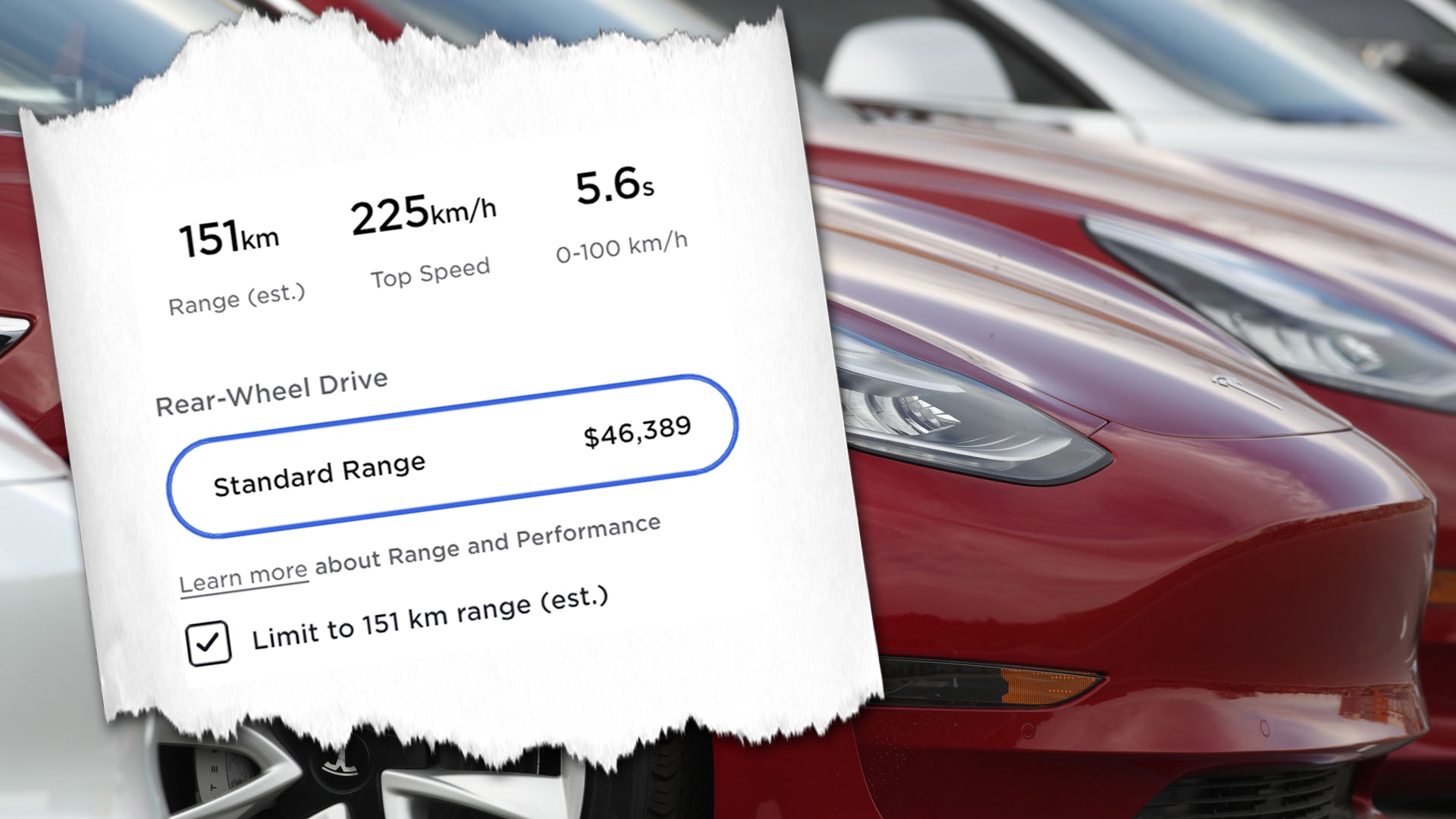

Earlier this year, we told you about Tesla’s ultra-low range Model 3 sold exclusively in Canada. The no-frills EV has only 94 miles (151 kilometers) of range and no Autopilot to boot. Thanks to these limitations, Tesla was able to price this particular example low enough to qualify for Canada’s Incentives for Zero-Emission Vehicles (iZEV) program—and as an added bonus, qualify the higher-up Standard Range Plus model as well due to the program’s unusual price cap system.
Unsurprisingly, it appears that the 94-mile range Model 3 isn’t a big seller. New data obtained from Transport Canada by The Drive shows that just over one-half of a percent of drivers who purchased a Model 3 and received Canada’s $5,000 iZEV credit actually sprung for the low-range variant. The workaround has cost the government of Canada—and its taxpayers—millions of dollars to subsidize the purchase price of the more expensive trim that would have otherwise not qualified for the incentive. About $115 million CAD, to be exact.

What Is the iZEV Credit, Anyway?
Canada’s system is quite different than the United States’ approach to a $7,500 post-sale federal tax credit. Essentially, the arrangement is a $5,000 credit used towards the purchase of a qualifying electric vehicle which is applied at the time of purchase—or a lesser amount if the vehicle is a plug-in hybrid or leased instead of purchased. Automakers submit an application to Canada’s department of motor vehicles, called Transport Canada, for specific models to be considered for the iZEV program. Once the model is approved, buyers can begin utilizing the incentive at the time of purchase to reduce their out-of-pocket expenses.
The meat and potatoes: The car’s base trim must be priced under $45,000 ($37,211 USD), but subsequent trims of the same vehicle must not exceed $55,000 ($45,481). This threshold means any trim of the same vehicle model can be considered for the credit as long as it’s under that price cap.

Tesla charges $52,990 for the Model 3 Standard Range Plus, however, buyers can opt to limit the vehicles to 94 miles (151 km) of range which drops the price down to $46,389. If you remove the $1,280 destination fee, the $100 air conditioning fee, and a $10 fee to the Ontario Motor Vehicle Industry Council, it brings the purchase price of the Model 3 SR+ to just $44,999—one dollar below the cut-off to qualify for the iZEV credit.
In this configuration, Tesla drops the “Plus” designation and just calls the vehicle Model 3 Standard Range—the same name as the previously-killed trim sold in the United States. However, the $35,000 (in U.S. dollars) Model 3 SR sold stateside was equipped with 220 miles of range. The Model 3 SR sold in Canada is priced at $44,999 CAD ($37,299 USD) and has just 94 miles of range.

This workaround means that buyers of the 263-mile Standard Range Plus variant can make use of the iZEV credit. Even more coincidental is that buyers can equip both Teslas with the 19-inch sport wheels and premium white interior to pay just $54,900 (before destination and other fees)—$100 less than the $55,000 cut-off.
Keep in mind that Tesla had previously canceled the Model Y Standard Range in the U.S. over concerns that its 250-mile range would be “unacceptably low.”
By the Numbers
Last year, the Canadian Taxpayers Federation obtained data showing that the Model 3 Standard Range sold a very limited number of cars—126 between from the time that the iZEV program launched in May 2019 until March 2020. The Drive reached out to Transport Canada to check in on these figures and learned that in more than a year’s time, only 25 additional units were sold.
From May 2019 until April 2021, Tesla sold just 151 units of the Standard Range Model 3, meaning that buyers received $755,000 in subsidies to use towards the lower-range EV. Meanwhile, it amassed a sale of 22,938 units of the Standard Range Plus. This makes a total of 23,089 sales eligible for the iZEV credit, or up to $115.5 Million paid out for a model that would have otherwise not qualified for the incentive.
In total, the iZEV program has paid out 87,919 total incentives, 26 percent of which have gone towards Tesla Model 3s—more than Audi, BMW, Chrysler, Ford, Honda, Mini, Mitsubishi, Nissan, Smart, Subaru, and Volkswagen combined. The automaker which had the vehicles with the second-highest number of incentives is Hyundai at 14,413, however, that number is split between six different models, three of which are plug-in hybrid which only receive half of the $5,000 BEV incentive.

Smart or Scam?
Not everyone is thrilled with Tesla’s gaming of the iZEV incentive. When we reported on the 94-mile Model 3 earlier this year, some called it “a great tactic” while others said that Tesla’s workaround was “a stupid dodge to get around a stupid policy.”
“It certainly looks like Tesla gamed the system by listing a no-frills model just under the maximum price in order to get access to millions in taxpayer subsidies for higher-priced models,” said Aaron Wudrick, federal director of the Canadian Taxpayers Federation during the outlet’s previous exposé on the Tesla Model 3 Standard Range. “Everyday taxpayers are subsidizing fancy cars for wealthier people.”
As for the DMV’s viewpoint, Transport Canada had previously refuted that it does not evaluate how an automaker markets its vehicles to consumers, only that it ensures eligibility criteria is met for the iZEV program. Its goal is simply to increase the affordability of battery-electric cars and the overall take-rate compared to gasoline-powered equivalents. And judging by the numbers, it did exactly that. The introduction of the Model 3 SR qualified the otherwise ineligible SR+ for the iZEV credit, something which certainly helped foster the adoption of EVs in Canada.
Whether or not Tesla’s move will be remembered as bold or below the belt is something yet to be seen. But one thing is certain: it worked.
Got a tip or question for the author? Contact them directly: rob@thedrive.com